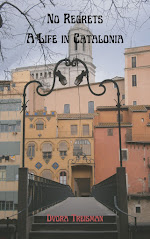 |
| Photo courtesy of Vanessa Bernardo |
But then it isn’t just shopping. Besides offering a wide variety of the best products, some exotic and many of them naturally and locally grown, the stalls of the city markets also offer a place to visit and chat. You deal with proprietors and their families and you get to know them. No one is in too big a hurry to schmooze for a while. It’s something like Facebook only it’s face-to-face. You chat a little, nothing too serious – the weather, the dismal economy, some gossip, how Barça did at their last game, or the best way to cook a particular dish (a sure way to involve everyone within hearing distance). It’s what we all did before there WAS a Facebook. It’s a way of maintaining the social capital (civic engagement and the face-to-face relations between people) that is being lost in the modern western world and particularly in the U.S.  .)
.)
Each of the mercats is distinct, taking on some neighborhood characteristics. Most are 19th century iron and glass structures, a few are more modern. In the Eixample, near the Parallel and not far from the historic campus of the University of Barcelona, the Mercat de Sant Antoni (currently housed in temporary quarters while being remodelled), a modernista iron and glass structure built in 1882, is surrounded, for four days each week, by stalls selling clothes and household goods, giving it a flea-market quality. On Sundays, when the regular market is closed, book dealers hold a second-hand book fair – a tradition that has been going on since before the Spanish Civil War. The Mercats Llibertat and Abaceria Central, both in Gracia, are also encircled by stalls of clothing and household goods.
The Mercat de Santa Caterina has, perhaps, the most striking exterior. Built on the ruins of the former 15th century Convent of Santa Caterina in the Ribera, this was the first covered market in the city, inaugurated in 1848. Remodeled in 2005, it is now housed in a gloriously colorful new superstructure, using the original walls but covered by a newly designed undulating tiled mosaic roof that is one of the new architectural attractions of the city, and well worth a visit, both for its unique exterior architecture, and the marvelous food within. One great plus if you’re sightseeing is that although far more women like to shop on vacation than men, most men truly enjoy visiting the city markets.
Social capital notwithstanding, you can shop right now, this minute, right there, all alone at your computer, and buy some to-die-for Spanish chocolate or Spanish extra virgin olive (not holy) oil
or Spanish extra virgin olive (not holy) oil . Do it! Enter my online shop and buy anything I’ve got listed there, or anything else from Amazon or any of its affiliates. To find my shop, click here or look for it at the top left, under the main blog headline. Whatever you buy during any visit to Amazon after entering through my portal helps me to earn some much-needed income. So do it often. Thanks!
. Do it! Enter my online shop and buy anything I’ve got listed there, or anything else from Amazon or any of its affiliates. To find my shop, click here or look for it at the top left, under the main blog headline. Whatever you buy during any visit to Amazon after entering through my portal helps me to earn some much-needed income. So do it often. Thanks!










No comments:
Post a Comment